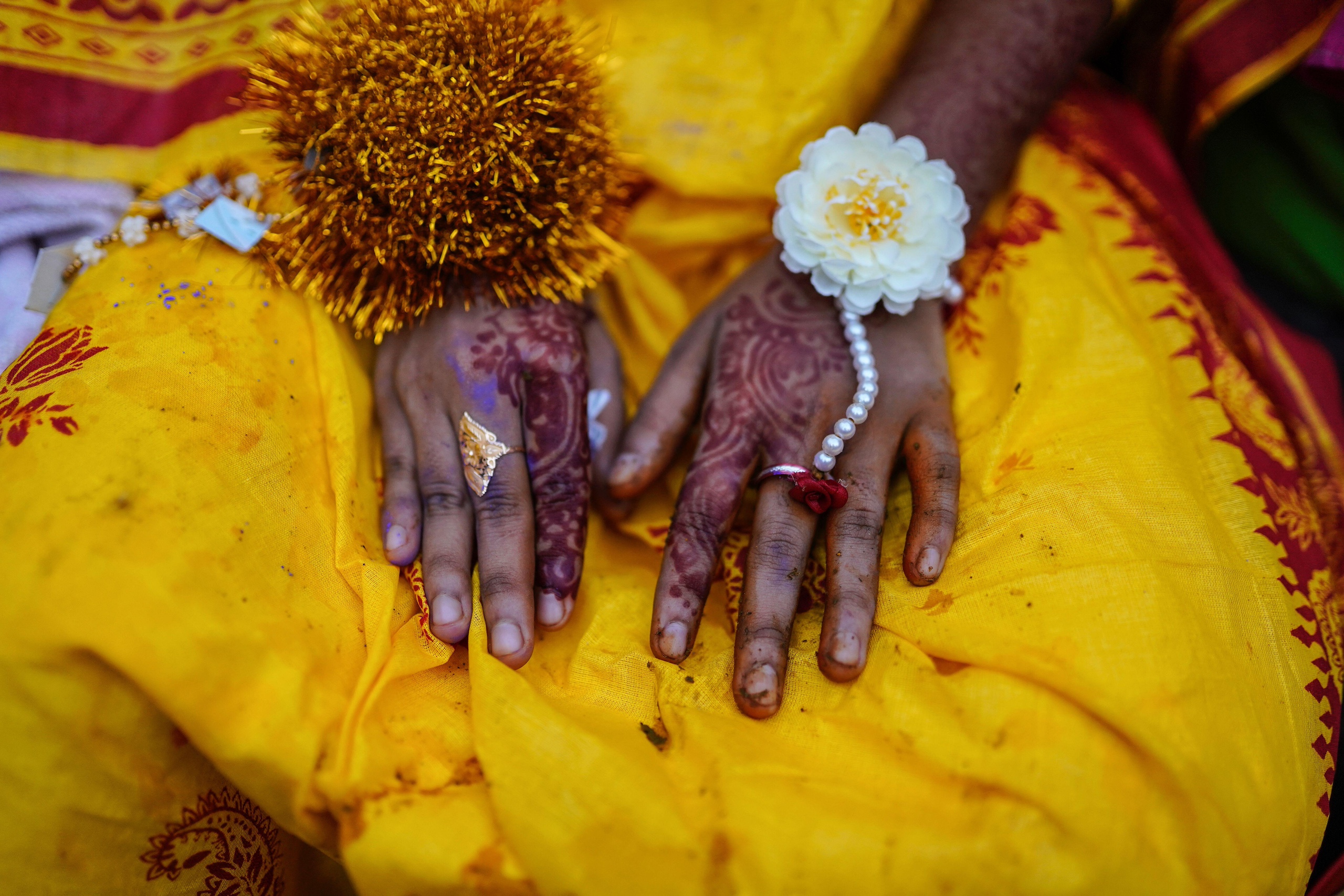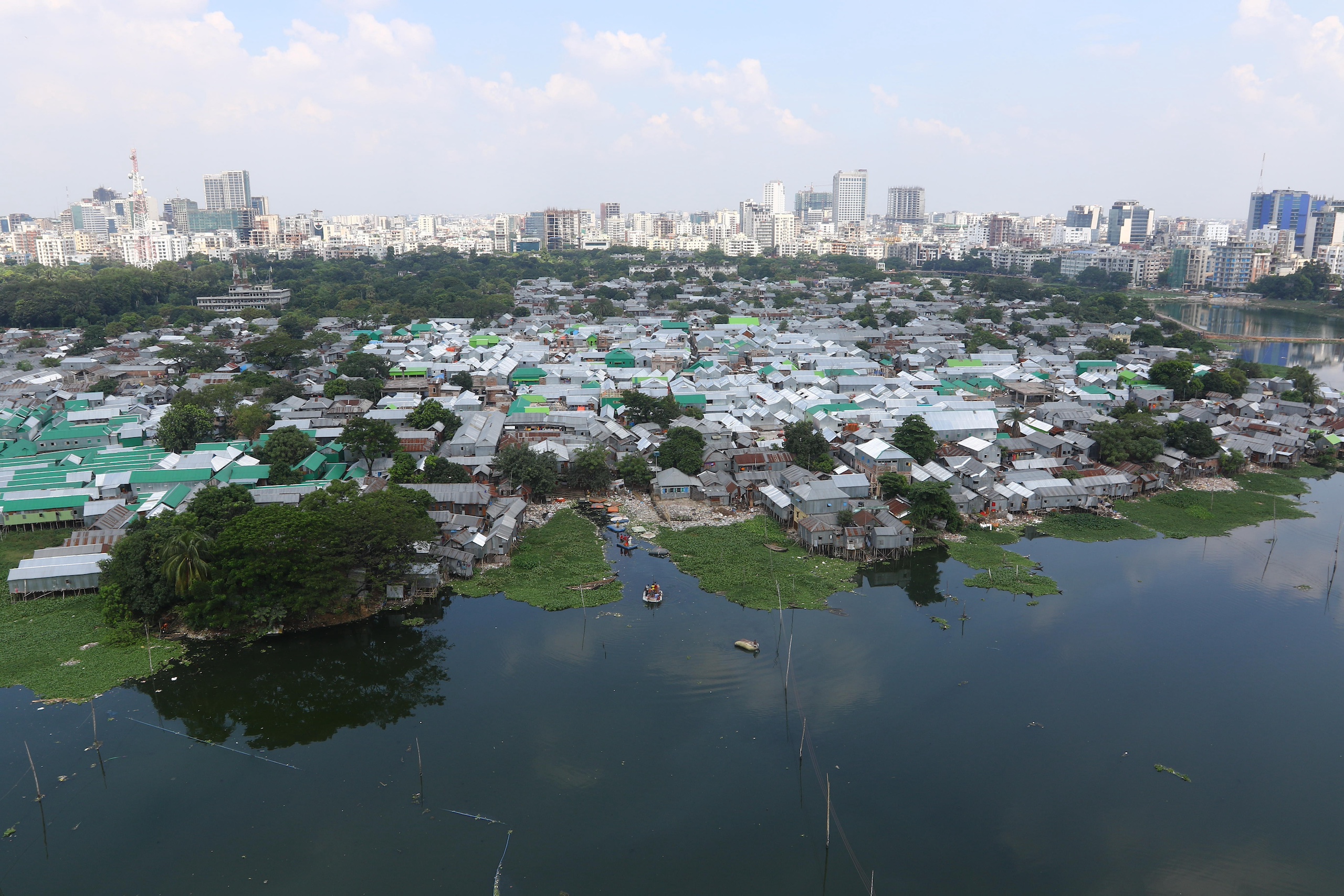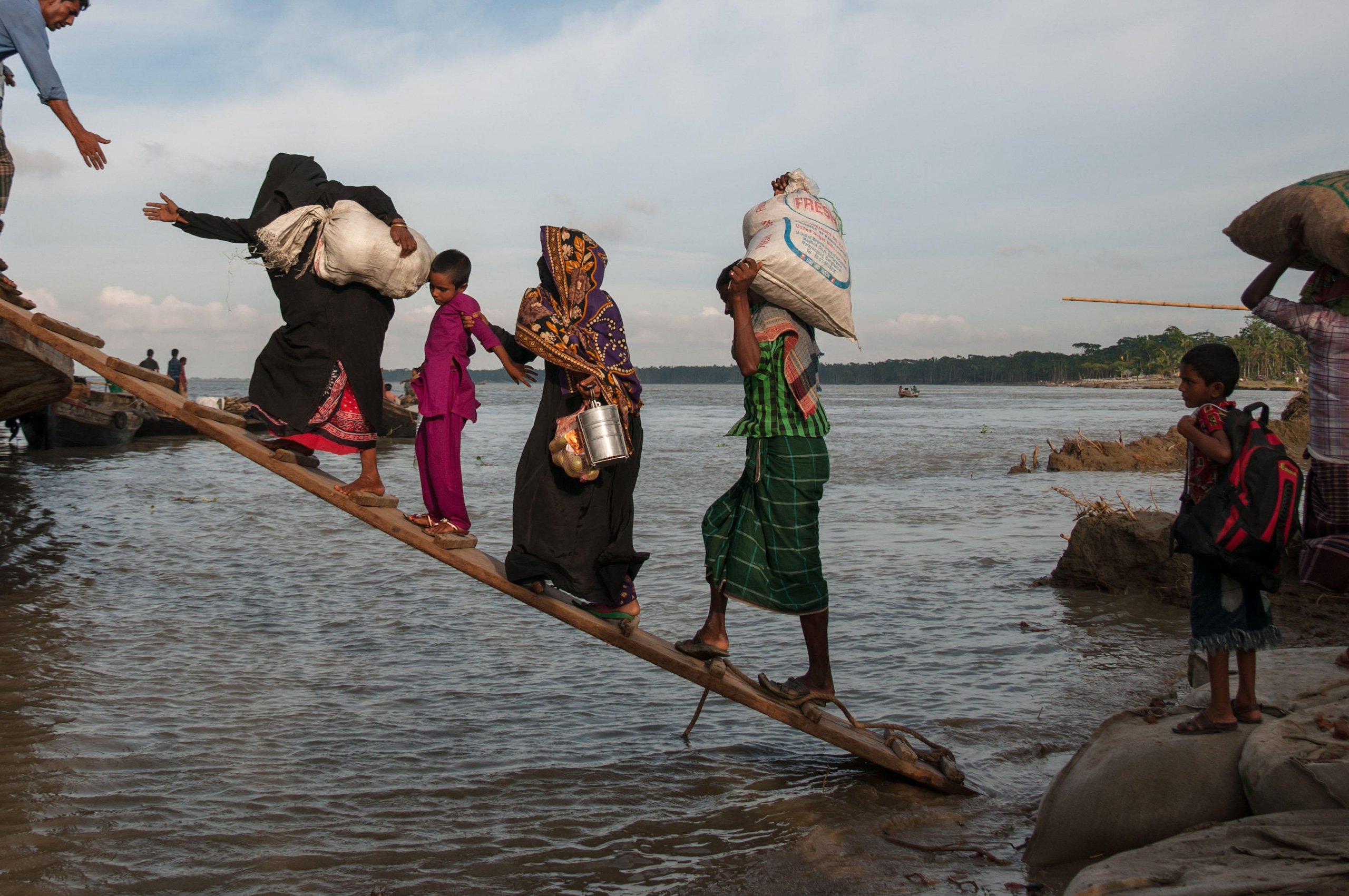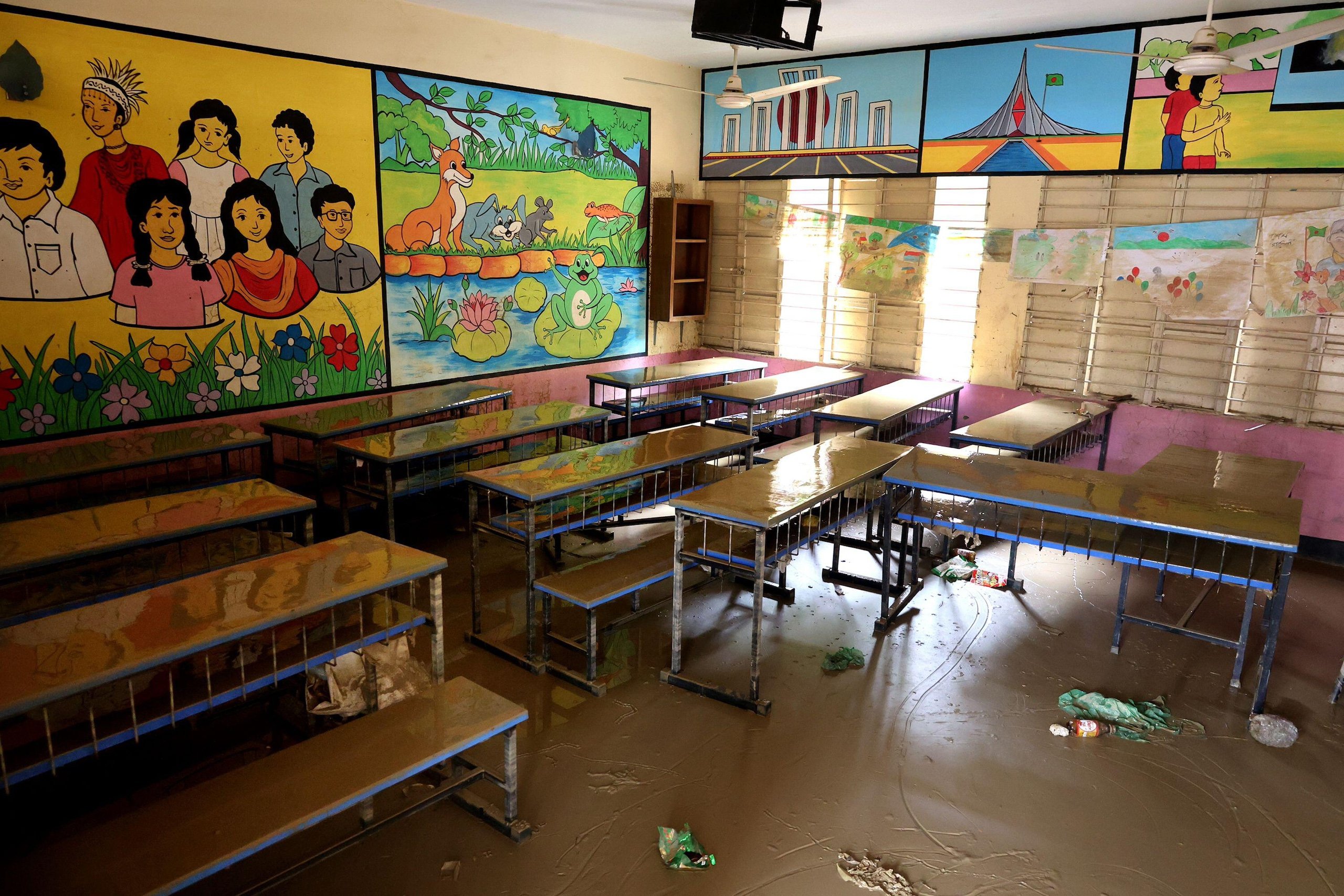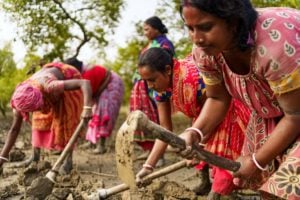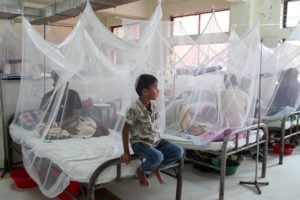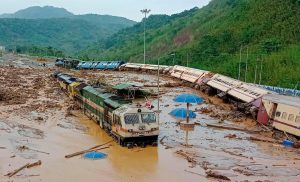Rukhsar Begum* is a 21-year-old woman from Rowmari, an area of Kurigram district in the north of Bangladesh. She and her family were displaced from their home on a riverine island on the Brahmaputra river during devastating floods that hit the area in 2015.
She now lives in Korail, a slum in the capital Dhaka, with her three children — two daughters aged 7 and 5, and a 3-year-old son.
Rukhsar was once hopeful about attending school. But she now faces a reality far removed from classrooms, as she was married off at the age of 15.
“I had a lot of dreams. But since the floods, it feels like that dream was drifting away on the river that took our home,” she told Dialogue Earth.
Rukhsar’s father, Ahmed Shakil*, expressed helplessness as he spoke about the decision to marry his daughter off at such a young age.
“It’s not what we wanted for her. But it was a fight for survival. I lost my ancestral home in the 2007 flood, then relocated to a slightly upper char [riverine island], and lost that home too in 2015. All my agricultural land was washed away and became a part of the river. Migrating to Dhaka was the only escape,” he said.
The family migrated from Kurigram to Dhaka with the help of Noor Chowdhury*, who had migrated before them to the capital. Chowdhury lived in the Korail slum and drove rickshaws to make ends meet. Two years later, Shakil agreed to marry Rukhsar off to the 37-year-old Chowdhury.
“If marrying her to someone meant we had one less mouth to feed, what choice did we have? Our jamai [son-in-law] saved us from dying when we lost everything,” said Shakil.
Rukhsar’s story mirrors the grim realities faced by an increasing number of girls from disaster-prone areas in Bangladesh forced into underage marriages.
Under the Child Marriage Restraint Act (1929), the legal age of marriage in Bangladesh is 18 years for a female and 21 years for a male. This is too often flouted. According to Unicef, Bangladesh has the highest prevalence of child marriage in South Asia, ranking eighth in the world.
A report published in 2023 by the Bangladesh Bureau of Statistics revealed that at least 41.6% of women married before the age of 18. Worse, it revealed that this proportion was going up. In 2022, 40.9% of women were found to have been married before turning 18. In 2021, the number was 32.4%, and in 2020, it was 31.3%.
In the same slum as Rukhsar and Noor, a 14-year-old girl interviewed by Dialogue Earth shared her fears about being married. She is a climate migrant, having moved with her family from Barisal division’s Bhola district after their home was destroyed by Cyclone Midhili in 2023. Their land, too, was lost to the Meghna river’s bank erosion.
“I hear my parents talk at night about my marriage. They think I’m asleep, but I hear everything. I am scared,” she said.
The social impact of climate disasters
In 2022, an International Rescue Committee (IRC) study highlighted a 39% increase in child marriages directly linked to climate change impacts.
The IRC’s research in disaster-prone areas such as Barisal, Bhola, Khulna, and Satkhira identified economic hardship, societal pressures, spikes in food prices, and financial crises as key drivers of child marriage following disasters.
According to the Internal Displacement Monitoring Centre, nearly 15 million Bangladeshis were displaced due to disasters in the period 2014-23, with most displaced due to storms (10.3 million) and floods (4.3 million). 2019, 2020, 2022 and 2023 were particularly bad years, with more than a million displaced in each them, and more than 4 million displaced in both 2019 and 2020.
The people living along the country’s 710 kilometre low-lying coastal region are most vulnerable. “Every day around 2,000 people migrate to Dhaka from coastal parts of the country, 70% of them due to natural disasters and climate change,” Atiqul Islam, mayor of Dhaka North City Corporation, told Dialogue Earth.
Dhaka is home to four million people living across 5,000 slums, while Chattogram’s 200 slums house nearly 1.4 million migrants. No data exists to show how many of these are climate migrants.
The government estimates, though, that by 2050, one in every seven Bangladeshis will be displaced due to climate change. Many of them will, inevitably, migrate to bigger cities like Dhaka in the hopes of finding some way to earn their livelihood.
Girls face greater risk
A report by global NGO Save the Children included Bangladesh among 10 nations considered “top 10 child marriage-climate hotspot countries”.
The NGO’s report also issued a stark warning: by 2050, nearly 40 million girls in these countries could be at extreme risk of enduring the harsh realities of child marriage driven by the climate crisis.
Wahida Zaman Shithi, health communications lead at Noora Health, who has worked in the disaster-prone Kurigram region for over a decade to combat child marriage, stresses the direct connection between disasters, displacement, socio-economic consequences and the prevalence of child marriage.
Child marriage has become a coping mechanism when a family struggles for survivalWahida Zaman Shithi, Noora Health
“Child marriage, as dire as it is, has become a coping mechanism when a family struggles for survival. After encountering multiple disasters and facing frequent displacement, the socio-economic strain can be overwhelming. They can’t even ensure a permanent sanitation facility and a reliable source of drinking water for their children. There is also fear of their [child’s] safety and security when it’s a daughter,” she said.
A 2021 study titled ‘The Mapping of Climate Change-Related Vulnerabilities and Child Marriage in Bangladesh’ also highlighted the devastating effects of environmental disasters on family stability, which is another driver for child marriages.
Mohammad Bellal Hossain, a professor at Dhaka University’s Department of Population Sciences and co-author of the study, told Dialogue Earth, “During our fieldwork for the research, we observed an uptick in girls being married off in the aftermath of floods and riverbank erosion.” He added, “When climate-exacerbated disasters like floods, riverbank erosion, cyclones, and storms destroy both public and private assets, the fallout goes much deeper than the visible damage.”
“Families whose homes are destroyed face not just the loss of property but they have to migrate as well, which escalates their economic and social vulnerabilities. During these calamities, when schools are damaged or destroyed, it interrupts the education of children, particularly girls, placing them at higher risk of child marriage. In such critical conditions, families resort to marrying off their daughters as a way to cope,” Professor Hossain explains.
The IRC study also illustrated how post-disaster challenges significantly contribute to child marriage.
It noted that 86.1% of girls experienced increased domestic duties, 37.4% faced greater caregiving responsibilities, and 30.9% lost educational resources — “factors that often lead families to consider marriage as a solution,” said Hossain.
He also added that the delays in the resumption of educational services can further exacerbate the risk of child marriage as the parents start viewing of them ‘economic burdens’.
IRC Bangladesh Director Hasina Rahman said, “Today in Bangladesh, half of the girls are married before their 18th birthday, while 22% are married before the age of 15.”
“This situation is, however, more volatile for the girls living in coastal areas, who are facing saltwater intrusion, food insecurity and poverty, irregular rain patterns, rising temperatures and heightened frequency and intensity of disasters,” she added.
* Names have been changed to protect the identity of vulnerable respondents.
